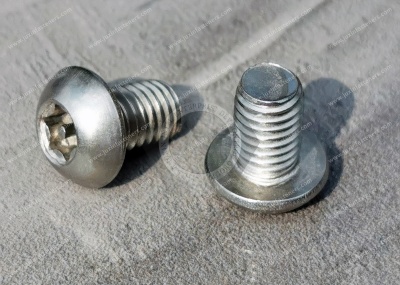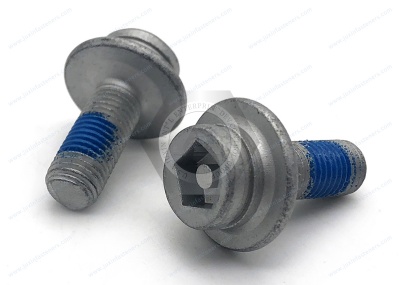Call Us
+86 136 6007 9809
Call Us
+86 136 6007 9809
Aug. 13, 2024
Materials and Manufacturing Processes for Automotive Fasteners
The development of automotive fastener tightening process technology and threaded fasteners is out of the joint reliability and structural lightweight needs. It results from the progress of threaded joint design, process, and material technology. The key to bolt coupling is to control the axial clamping force of the bolt. To realize the accurate control of the bolt axial force, it must be selected from the design of fasteners, friction coefficient control, the correct use of tightening process methods, and other aspects to be ensured.
Most high-strength bolt steel is medium-carbon steel and medium-carbon alloy steel, is used after heat treatment in the tempered state. Through heat treatment (tempering), its microstructure is tempered by martensite + carbides. After the austenite hyperfine before quenching, it is proved that its mechanical properties can be improved, compared with the traditional acceptable grain heat treatment of 42CrMo steel; when refined to less than 10um, all the mechanical properties (strength, plasticization, steeliness) are significantly improved. For high-strength bolt steel, only to improve the toughness or only grain refinement can not fully meet the requirements. For example, in the vast majority of alloy structural steel, when the tensile strength is increased to 1200MPa after the delayed fracture, that further increases the strength of the loss of value but causes greater insecurity. From a practical point of view, improving fatigue strength and life to enhance the performance of delayed fracture is a vital and complex subject.
Improvement of fatigue resistance is linked to the improvement of cleanliness in the steel, especially the size and distribution of oxide changes; it is a difficult challenge for the production of this type of steel in the electric furnace metallurgical process, which requires strong collaboration in all aspects. Improvement of delayed fracture strength is related to grain refinement and the structure and grain boundary state in steel. Scientific studies have shown that 42CrMoVNb ~ when the austenite grain refinement to 2um, delayed fracture is not better than the coarse grain size (4um); delayed fracture is essentially a hydrogen embrittlement phenomenon, usually develops in the form of along-crystal fracture, and thus susceptible to delayed hydrogen embrittlement fracture in use.
The development of secondary hardening steel, rather than the general strength of tempered steel, is higher than 200 to 400MPa, which can be illustrated through the cold working of steel. When a steel specimen is loaded to its yield limit, the load is rapidly removed. At the second loading, the strength of the steel increased significantly but exhibited a decrease in both plasticity and toughness.
Serrated-Flange Socket Head Screws:Serrations under the head grip the material's surface for mild vibration resistance, and the flange distributes pressure, eliminating the need for a separate washer. With a tensile strength of 140,000 psi, these alloy steel screws are comparable in strength to Grade 8 steel screws and are more potent than stainless steel screws. Their black-oxide finish provides mild corrosion resistance in dry environments. Head height includes the flange. Length is measured from under the flange.
Sealing Socket Head Screws: A rubber O-ring under the head of these screws prevents leaks and seals out contaminants. Dimensions meet ASME B18.3 or ISO 4762 (formerly DIN 912) specifications. Length is measured from under the head.
18-8 stainless steel screws have good corrosion resistance and may be mildly magnetic.
Three hundred sixteen stainless steel screws are more corrosion resistant than 18-8 stainless steel screws and have excellent resistance to chemicals and salt water. They may be mildly magnetic.
Screws with a Buna-N O-ring withstand wet and abrasive environments.
Screws with a silicone O-ring are suitable for a wide range of temperatures and resist corrosion from salt water.
Coarse threads are the industry standard; choose these screws if you don't know the pitch or the threads per inch. Fine threads are closely spaced to prevent loosening from vibration. They are not compatible with coarse threads.


Alloy Steel Shoulder Screws: Comparable to Grade 8 steel, these alloy steel shoulder screws are the strongest we offer. They have a standard shoulder with an undersized tolerance for most machinery and equipment. Also known as stripper bolts, they're commonly used in punch and die assemblies and as an axle or pivot point.
Metric Alloy Steel Shoulder Screws: Comparable to Class 12.9 steel, these alloy steel shoulder screws are the strongest we offer. They have a standard shoulder with an undersized tolerance for most machinery and equipment. Also known as stripper bolts, they're commonly used in punch and die assemblies and as an axle or pivot point.
Same-Size Thread Alloy Steel Shoulder Screws: With threads the same diameter as the shoulder, these screws can handle heavy loads. Made of alloy steel, they are comparable in strength to Grade 8 steel. A standard shoulder with an undersized tolerance allows them to fit most machinery and equipment. Also known as stripper bolts, they're commonly used in punch and die assemblies and as an axle or pivot point.
Short-Thread Alloy Steel Shoulder Screws: Use these screws in thin materials; they have a shorter threaded portion than our standard shoulder screws. They're comparable in strength to Grade 8 steel. A standard shoulder with an undersized tolerance allows them to fit most machinery and equipment. Also known as stripper bolts, they're commonly used in punch and die assemblies and as an axle or pivot point.
18-8 Stainless Steel Shoulder Screws: Made from 18-8 stainless steel, these shoulder screws have good chemical resistance and may be mildly magnetic. A standard shoulder with an undersized tolerance allows them to fit most machinery and equipment. They're often used to guide or align components and as an axle or pivot point.
Passivated stainless steel screws have added protection against oxidation and corrosion.
Black-oxide stainless steel screws have a matte-black finish.
In addition, through microscopic observation, the atomic lattice distribution of the cold-drawn steel was neater and more regular than that of the original, indicating the improvement of its strength properties. The Nb fine crystallization of the steel was achieved at the same time as the austenite acceptable crystallization heat treatment using electric heating treatment and cyclic heat treatment. The use of polarization in the austenite grain boundaries, through low-energy electron diffraction and grain boundary temperature calculations, proves the strengthening of the atomic phase of the grain boundaries.
There have been 1300MPa levels of high-strength bolts in the use of examples due to the optimization of product design and improved product quality, and high-strength bolts have put forward higher requirements. Recently developed new material 42CrMoVNb (ADF1) steel in the Iveco car and Cummins engine for 13.9 ~ 14.9 level of high-strength bolts used to break through the international highest only 12.9 level of bolt steel limitations, ultra-high-strength bolts steel can be expected to have an excellent market prospects, very high production potential.
Heat treatment can design high-strength fasteners to obtain the required strength, good plasticity, toughness, low-notch sensitivity, and high flexural strength. This avoids the phenomenon of relaxation and other comprehensive mechanical properties and their performance, ensuring the quality and reliability of fasteners and improving the competitiveness of products in the market.
The heat treatment process of high-strength fasteners, especially their intrinsic quality, has a critical impact. Therefore, to produce high-quality, high-strength fasteners, there must be an advanced heat treatment process and heat treatment process control. The heat treatment process is characterized by changing the internal organization of the material so that a variety of fasteners can obtain the required performance and quality. Because the heat treatment of the quality characteristics of the product is often not intuitive intrinsic quality (such as material tensile strength, sectional shrinkage, elongation, etc.), the production to ensure the quality of the heat treatment, generally through specialized instrumentation on the fasteners or with the furnace specimens for testing. Due to the limitations of the inspection sampling rate and inspection parts, for each specification fasteners and even each furnace fasteners, the test is local or individual, it is impossible to achieve 100% of the heat treatment quality testing. All the test results can not fully reflect the heat treatment quality of the whole batch of fasteners. As heat treatment is produced by furnace batch input or continuous production, heat treatment quality problems result in incalculable losses. Strict control of the whole heat treatment production process and comprehensive quality management are significant for the heat treatment process. Heat treatment production with other production processes, as inseparable from the people, machines, materials, methods, and environment, are the main factors affecting the quality of heat treatment products, mutual influence, and mutual constraints, and ultimately determine the quality of heat treatment of fasteners.
For high-quality Alloy Steel Shoulder Screws for High Vacuum and professional technical support, please get in touch with us at adelajonly@gmail.com or visit our website at https://www.juxinfasteners.com.
Contact Us
Tel.:
+86 020 8621 0320
+86 020 3121 6067
Technical Support:
Navigation
SEND INQUIREY